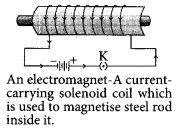Magnetic Effect of Electric Current
1.Give reason for the following:
(i) There is either a convergence or a divergence of magnetic field lines near the ends of a current carrying straight solenoid.(ii) The current carrying solenoid when suspended freely rests along a particular direction.
Ans:
(i) There is either a convergence or a divergence of magnetic field lines near the ends of a current carrying straight solenoid because it behaves similar to that of a bar magnet and has a magnetic field line pattern similar to that of a bar magnet. Thus the ends of the straight solenoid behaves like poles of the magnet, where the converging end is the south pole and the diverging end is the north pole.
(ii) vertically in East – West plane and an observer looking it from south sees the current to flow in anticlockwise direction,
(iii) horizontally and an observer looking at it from below sees current to flow in clockwise direction.
Ans:
According to right hand rule, the direction of magnetic field is
(i) west to east
(ii) north to south
(iii) into the paper.
(a) State three factors on which the strength of magnetic field produced by a current carrying solenoid depends.
(b) Draw circuit diagram of a solenoid to prepare an electromagnet.
Ans:
(a) Strength of magnetic field produced by a current carrying solenoid depends upon the following factors:
- number of turns in the coil
- amount of current flowing through it
- radius of coil
- Material of core of the solenoid.
(b) A strong magnetic field produced inside a solenoid can be used to magnetize a piece of magnetic material, like soft iron, when placed inside the coil. The magnet so formed is called an electromagnet.
4. Write one application of right hand thumb rule.
Ans:It is used to find the direction of magnetic field around a current carrying conductor.
5. A current carrying conductor is placed in a magnetic field. Now answer the following.
(i) List the factors on which the magnitude of force experienced by conductor depends.
(ii) When is the magnitude of this force maximum?
(iii) State the rule which helps, in finding the direction of motion of conductor.
(iv) If initially this force was acting from right to left, how will the direction of force change if:
(a) direction of magnetic field is reversed?
(b) direction of current is reversed?
Ans:
(i) When a current carrying wire is placed in a magnetic field, it experiences a magnetic force that depends on
(a) current flowing in the conductor
(b) strength of magnetic field
(c) length of the conductor
(d) angle between the element of length and the magnetic field.
(ii) Force experienced by a current carrying conductor placed in a magnetic field is largest when the direction of current is perpendicular to the direction of magnetic field.
(iii) The rule used in finding the direction of motion of the conductor placed in a magnetic field is Flemings left hand rule.
Fleming’s left hand rule is as follows:
Stretch out the thumb, the forefinger, and the middle finger of the left hand so that these are at right angles to each other. If the forefinger gives the direction of the magnetic field (N to S), the middle finger the direction of current then the thumb gives the direction of the force acting on the conductor.
(iv) (a) Direction of force will be reversed when direction of magnetic field is reversed, i.e., now force on conductor will act from left to right.
(b) Direction of force will be reversed, if the direction of current is reversed, i.e., the force on the conductor will act from left to right.
Ashwani Kumar
ashwanikmr82@gmail.com

Best content...keep it up
ReplyDelete